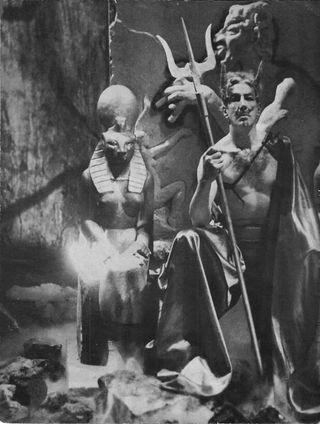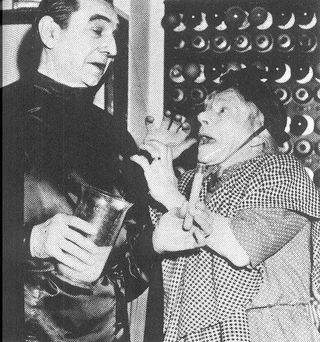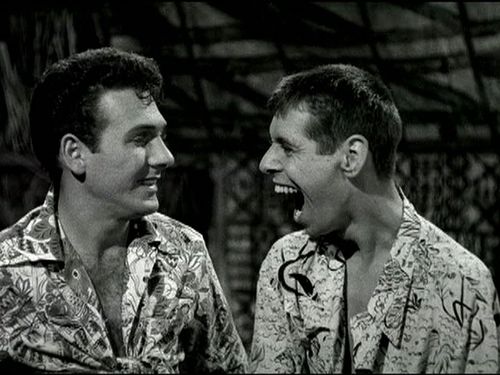
With Thanksgiving under my belt, my thoughts always turn to turkeys. Not only conjured up images of the on-the-table-carving-kind with stuffing and cranberries, but also movies considered the worst on the silver screen–past and present. One web site I'm always checking out, as well as occasionally contributing to–at least in submitting an occasional vote–is the Razzies, where candidates for the past year's worst achievements are listed and voted on. The Golden Raspberry Awards have been around, and going strong, since March 31, 1981. A similar site, Rotten Tomatoes, was launched August 12, 1999. Pre-dating them is the yearly Harvard Lampoon "Worst of… " Awards. On Saturday, April 23rd, 1966, Natalie Wood made history when she became the first performer to show up at Harvard and graciously accept her award after being voted the year's Worst Actress .
Speaking of the Worst…
In the early 1960s, in the uncharted wastes of New Jersey, dwelled one young fan who was caught up in monsters, both classic and modern. Through the pages of magazines like Famous Monsters of Filmland and Castle of Frankenstein he was made aware of other kindred spirits who existed. They were appearing in FMoF's and CofF's pages since any and all were invited to submit letters, photos and mentions of fan clubs. This young fan was determined to have a letter, or at least a mention, in FMoF. He wrote to editor Forry Ackerman of his love for monster films and how much he loved reading FMoF. No response. He wrote of what he and his friends did when they were not attending school. Again, no response. He submitted a list of what he thought were the best classic and contemporary fanta-films. Again, no response. Maybe a serious re-thinking and change of concept was in order? So this young fan compiled a list of monster (and science fiction) films he thought were the worst. Although thematically cynical, this list was ahead of its time. This cynical young fan was future film director Joe Dante.
I digress…
Prior nods to the not-the-greatest horror and sci-fi films had been in the pages of FMoF and another Ackerman-edited magazine running concurrently, Spacemen. The premier issue of FMoF (1958) in the Out of This World Monsters article featured a still of the Ro-man with the caption "Robot Monster, the film so horrible it was not released, it escaped." One could easily ascertain the usage of the word "horrible" was used here not to mean anything horror-filled, but rather to imply a bad quality. The premier issue of Spacemen (July 1961) ran a full page photo of the aliens from Invasion of the Saucermen with the less-than-complimentary comments of them resembling "cabbage heads" and "heads that resemble meatballs with spaghetti" in the Orbituary Department. Issue #3 (April, 1962) contained a request from readers (one cheekily named 'Hans Orlac'), also in the Orbituary Department, to see a photo of "those unbelievably ridiculous popeyed planetmen from Killers From Space."
The young fans of FMoF and Spacemen (both periodicals presumably originating from the same typewriter of Unkka Forry) took no exception to the less than sterling comments of the films they were enjoying both on TV as well as on the big screen. Good films were enjoyable. Bad films were equally as enjoyable, mainly because they were bad. It was all taken in fun.
 Okay, now back to Joe Dante…
Okay, now back to Joe Dante…
A few weeks later his telephone rang. It was Forry Ackerman. Bang! The Ackermonster himself was calling him from the other side of the country…from the Ackermansion! He had read his list of 50 worst horror and sci-fi films with the utmost interest. Permission was asked if it could be expanded and embellished to be featured in the next issue of FMoF. Now a starry-eyed fan, he would be credited as the author!
Within a few months a huge envelope arrived with complimentary copies of FMoF #18 (July, 1962). On page 14 began what had now morphed into Dante's Inferno. There it was, a full-fledged article! Containing, as Dante later commented, "words that he didn't even understand." The 50 "worst films" listing was in alphabetical order begining with Adventure Island (1947) and winding up with Zombies on Broadway (1945). Two of Ed Wood's films were included: Bride of the Monster was listed as #7, and sandwiched between The Phantom From 10,000 Leagues (listed as Phantom of 20,000 Leagues) and Revolt of the Zombies was Plan 9 From Outer Space at #39. The entire comment was "I had heard a lot about Plan 9 From Outer Space and saw it to see if it was as bad as they said [although he doesn't elaborate on who "they" were]. It was even worse! There is a distinct possibility that it was the cheapest film ever made. The entire cast was awful. Special effects were laughable and even the old clips of Bela Lugosi were poor. The scene where Tor Johnson rose from the grave was the only good 5 seconds in the whole film. Vampira, Johnson, Lyle Talbot all wasted."
Similar pans described the other titles in Dante's Inferno. Soon after, Joe Dante was listed in CofF #3 (1963), and by issue #4 was a contributing editor. His editorial duties included compiling the Frankenstein (TV) Movie Guide. In his reflections of FMoFs 1 though 50 in Famous Monster of Filmland (Imagine, 1986), Forry Ackerman, writes about Dante's Inferno and the repurcussions it caused. He wrote that the young fan from New Jersey was a "Joe Nobody" and that he truly felt no one would take the article seriously. However, FMoF's publisher Jim Warren irately told him American International's president James H. Nicholson was fuming. His company was planning to reissue a few of the titles panned in the article. It was also made known that if FMoF were to now run articles putting down Imagi-Movies, it could be devastating. Producers and releasing companies would not want to promote anything, past or present, on the magazine's pages. Warren flatly told him "Don't ever run a criticism of another picture!"
So…
Two issues later a full page photo was printed in the beginning of the magazine. It depicted a large trophy sitting on the desk of a beaming James H. Nicholson. The trophy was the (first) Famous Monsters of Filmland Magazine Producer's Award for "the horror hit of 1962 – AIP's The Pit & the Pendulum." Pacified, Nicholson was smiling as Warren was proudly admiring it.
And what's more…
Evidently, one of the auteurs whose films Dante panned, Roger Corman, with Teenage Caveman #44 on the list, either forgave him or paid it no attention. Less than 20 years later Corman's New World Productions handled Hollywood Boulevard, and Piranha–both featuring early directing duties by Dante. Corman functioned as Associate Producer for both films.
By the time I had read Dante's Inferno I had caught an airing of Plan 9 on television. As a pre-teen monster fan I thought of it as a bit odd. Other fanta-films seemed to have more substance and looked better. Now here was someone out there in the world that caught the same eccentricities I was observing while viewing these films. Here with this listing were many more. To me it all fell in to the general appreciation for them. Watching a film either on TV or in the movies, especially with friends, was all part of fandom. The fun was in either being generally thrilled by a truly scary film, or having a good laugh with it. Plan 9's (as well as Bride of the Monster's) auteur was not mentioned in Dante's Inferno, but recognition would come soon after his death. His body of work would be resurrected, reappraised, reevaluated and heralded…as the worst.
Now about Ed Wood Jr…
1978, the year Edward Davis Wood Jr. died at the age of 54, saw the publication of a book titled The 50 Worst Films of All Time (Popular Library). The authors were listed as Harry Medved with Larry Dreyfuss. Listed were films af all genres, touching on a few horror and sci-fi films. Mixed in with titles like The Conqueror, Myra Breckenridge, Lost Horizon and Valley of the Dolls, were titles like Eegah!, The Horror of Party Beach, Robot Monster and Santa Claus Conquers the Martians. All truly deserving of inclusion in a book listing the worst. Hidden in the back of the book on page 284 was something unique, a form to be cut out (or xeroxed like I did) and sent to Michael Medved in Venice, California, listing your (the reader's) favorite worst films. This little element gave a hint as to who really authored The 50 Worst Films of All Time. As was revealed a few years later, Michael Medved did the bulk of the writing. He didn't want his name associated with the book mainly because he was working at establishing a career in Hollywood as a screenwriter. It has also been established he was working as a script doctor.
Anyway, the mail-in-your-worst-films poll was counted (with yours truly prominently among the results), instigating a follow-up book, Golden Turkey Awards (Perigee Books, 1980). Here was a listing by brother authors Harry and Michael Medved (whatever became of Dreyfuss?) naming and awarding film turkeys, "Golden Turkeys" no less. This bad film label sat a little better with readers than what a popular TV critique show running at the time was using. At the end of the Siskel and Ebert show they would comment on a film they determined to be the Dog of the Week. This didn't endear them to viewers who had and loved those cinematic pet dogs.
But what about the poll's results?
As a result of the 50 Worst Films of All Time mail-in poll, the two movies that came out on top as the undeniably worst were The Exorcist II, the Heretic and Plan 9 From Outer Space. Neither were originally listed in their previous 50 Worst Films of All Time. This dubious distinction sparked the interest in Ed Wood Jr., who to this day still holds the title of the Worst Director ever. Extensive comments were included about Plan 9, Ed Wood Jr., and an overview of his films.
Four years later the Medveds published The Hollywood Hall of Shame, subtitled The Most Expensive Flops in Movie History. Nowhere is listed Ed Wood Jr. or any of his films.
And then…
Bill Warren, in his early editions of Keep Watching the Skies states "In The Golden Turkey Awards, the reprehensible Harry and Michael Medved, who consistently display a repulsively arrogant attitude toward the efforts of helplessly untalented but comparatively more sincere people…" in his commentary on Plan 9, calls their book "contemptible." By the 2010 edition of his book Warren omits the "reprehensible" and "contemptible." He adds that Harry "has reformed [at least by his standards] and has become a good writer on film subjects with a fondness for Plan 9."
In 1996 another book listing movie turkeys was published: The Worst Movies of All Time, or What Were They Thinking? (Citadel) by Michael Sauter. Not particularly well researched, it covered much the same ground as the Medved books, and then some. Wood and his films were given sporadic mention in the final part, The Baddest of the B's.
 Now back to Joe Dante…and a wrap up with Bela and Ed Wood…
Now back to Joe Dante…and a wrap up with Bela and Ed Wood…
At Unkka Forry's 75th Birthday party I sat at the same table with Joe Dante. In between his signing autographs we chatted. We briefly touched on his Dante's Inferno article. Also at this party was Mark Carducci, who was finishing up filming his documentary Flying Saucers Over Hollywood, a Plan 9 Companion (1992). Dante, along with several others, spoke to the partygoers. He mentioned the whole incident about writing to Forry and eventually getting his letter listing the 50 worst films published. This section of his talk made it into Carducci's documentary. Also in the documentary are comments by Harry Medved. He revealed that he was influenced, of sorts, by Dante's Inferno. Ironically, none of the films listed in Dante's article were listed in the 50 Worst Films of All Time book. It took solicited reader response and another book to re-discover Ed Wood Jr. and his films.
Viewing and evaluating the films Bela Lugosi was appearing in towards the end of his life one can see his association with Wood wasn't the worst that could've happened to him. Wood maintained a genuine fondness for Bela and was always looking to include him in some sort of project he had going. This was to keep him active and possibly provide some money.
Two films he had appeared in just one year before Glen or Glenda stand out as being worse than anything Wood could have ever concocted: Old Mother Riley Meets the Vampire (aka Vampire over London, My Son the Vampire, King Robot, The Vampire and the Robot, ad nausem) and Bela Lugosi Meets a Brooklyn Gorilla (aka The Boys From Brooklyn).

The titles of these films alone could warn anyone away from a theater showing them. Old Mother Riley Meets the Vampire (released or escaped in the US in 1962), came about at a time when Bela was being shamelessly exploited by the Gordons, Richard and Alex. William 'One Shot' Beaudine, director of Bela Lugosi Meets a Brooklyn Gorilla, has subsequently been derided in print by Warren as well as the Medveds. How many remember Arthur Lucan, aka, Old Mother Riley? How many remember Duke Mitchell and Sammy Petrillo, the Brooklyn boys in Brooklyn Gorilla?
ZC Note: Just us bad movie buffs, at least, remember. And I'm from Brooklyn!
